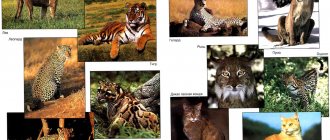The word “tiger” comes from the Greek τίγρις, and it comes from Persian, and was translated as fast and sharp. This name did not appear by chance. During the hunt, he sneaks up on the prey or waits for it in ambush, then overtakes it with several jumps and immediately grabs it by the throat with its sharp fangs.
The main food of tigers are ungulates, but they almost never attack large animals, such as adult elephants, because inferior to them in size. But, nevertheless, tigers are considered one of the largest land predators.
In this article we will talk about the largest tigers in the world, how much they weigh, where they live and how many of them are left on the planet.
Malay, up to 120 kg
They live only on the Malay Peninsula.
Until 2004, experts were sure that he was an Indochinese tiger. But then it was separated into its own subspecies at the insistence of a group of scientists. In appearance, the Malayan tiger is indeed similar to the Indochinese tiger, but differs from it in its size. Females weigh no more than one hundred kilograms (body length – 200 cm), and the weight of males reaches 120 kg (body length – 237 cm). The territory of a male is about 100 km², and up to 6 females can exist on it.
Now there are only about 600-800 individuals in the wild, which is not so bad when compared with other subspecies. This tiger is considered a symbol of Malaysia; its images can be found on the coat of arms of the state and many institutions.
The king of beasts and the tiger - who is the strongest?
Many people are interested in this question. In fact, little is known about actual fights between lions and tigers. Therefore, there is no sufficient reason to claim that one of the predators is stronger than the other.
- A tiger and a lion can be compared by external features or lifestyle.
- In terms of weight, a tiger is 50-70 kg heavier than a lion.
- Both animals clench their jaws with equal force.
- Lions and tigers kill their prey in the same way. They bite the victim's neck with powerful fangs.
- If we compare the lifestyle, it is very different for two different predators.
So, the tiger hunts alone, he hunts in his own territory. They practically do not collide with each other; when males go hunting, they do not meet.
- Detailed description with photos of all animals included in the Red Book of Russia
Zebra - habitats, appearance, diet and behavior, life cycle + 94 photos
Leopard - habitats, life cycle, rutting season and lifespan + 118 photos
Lions live in prides or clans. Males have to fight to have the right to hunt. They often engage in fights for females during the mating season. Such battles can result in serious injury or death of the male.
It is difficult to decide unambiguously which animal is stronger.Based on endurance, it is difficult to say who is in the lead. Both animals are excellent runners, and endurance is affected by age, habitat and health status.
Sumatran, up to 130 kg
Found only on the island of Sumatra. It is considered one of the smallest species, but is also one of the most aggressive. It is orange or slightly reddish in color, with black stripes, they are even on the paws. The length of females is from 1.8 to 2.2 m, and that of males is from 2.2 to 2.7 m, females weigh from 70 to 90 kg, males are slightly larger - from 110 to 130 kg.
It chooses jungles, mountain forests, and savannas to live, giving preference to areas with rich vegetation.
The Sumatran tiger does not like to sit in ambush. Having sniffed out the prey, he first sneaks up to it, and then jumps out on it from his hiding place and begins the chase. Their small size and powerful paws are adapted for long pursuits; they can cover enormous distances, sometimes without leaving their prey for several days.
The Sumatran game is on the verge of extinction, currently there are no more than 300-500 species left. The Indonesian authorities are doing everything possible to preserve it; they created a reserve for these animals back in 2011.
Largest land animal
The largest land animal is the elephant. Its weight can reach 7 tons (the maximum recorded by the Guinness Book of Records is more than 12 tons), its height is more than 3 meters. With the help of its trunk, an elephant can lift weight up to 250-275 kilograms. It is known that African elephants, if necessary, can pick up and carry their cubs with their trunks, which already weigh more than 100 kilograms at birth. The maximum weight that elephants can drag behind them, according to various sources, is from 1 to 2 tons.
Javanese, up to 130 kg (extinct)
This subspecies once lived on the island of Java, but to date there are no representatives left. Presumably they died in the 80s of the 20th century. But they have been on the brink since the 1950s, when their number did not exceed 25 pieces.
The Javan tiger was last seen in 1979, and there are speculations that there are still animals left somewhere on the island, but this has not been confirmed. They were seen in that part of the island that is covered with virgin forest. But it could also be leopards.
Males of this species weighed from 100 to 141 kg, their body length was about 245 cm. The weight of females was even less, from 75 to 115 kg.
Tiger
The largest and most fearsome of the big cats is the tiger. The tiger is one of the largest land predators, second only to the polar and brown bears. Nine subspecies of the tiger have been identified, of which only six had survived by the beginning of the 21st century. The total number of tigers at the moment is about 4000-6500 individuals, of which the most numerous is the Bengal tiger. In the 20th century, the tiger was included in the Red Book. Hunting for it is prohibited throughout the world.
The tiger is the largest and heaviest of the wild cats, but its various subspecies vary greatly in size and body weight. Adult male Amur tigers can reach up to 2.3-2.5 m, and in some cases up to 2.6-2.8 meters in length without a tail and weigh up to 275 kg, sometimes up to 300-320 kg. Tigers of those subspecies that live in the tropical regions of the Asian range are somewhat smaller.
The tiger is an exclusively Asian species. The historical range of the tiger (now strongly dissected into separate populations, sometimes very distant from one another) is located in the Russian Far East, Iran, Afghanistan, China, India and the countries of Southeast Asia, including the Sunda Archipelago (Indonesian Islands).
The habitat was formed in northern China about 2 million years ago. About 10,000 years ago, tigers moved south through the Himalayas and eventually spread throughout almost all of India, the Malay Peninsula and the islands of Sumatra, Java and Bali. A few centuries ago, its habitat extended from Kazakhstan to the Sunda Islands, from Northern Iran to the mouth of the Amur. Now, in most of this territory, tigers have been exterminated; the largest populations remain in India and Indochina. Within Russia, a small population of tigers is found only in the Far East, in the Primorsky and Khabarovsk Territories. Between 1995 and 2005 alone, the tiger's range in Asia shrank by approximately 40%, leaving the tiger in only 7% of its original range.
The habitats of tigers can be very diverse: tropical rainforests, mangrove swamps and bamboo thickets in the tropics, dry savannas, semi-deserts, bare rocky hills and taiga in the north.
In the zoo, against the background of the back wall of the cage, the tiger amazes with the brightness of its color - orange with black stripes. But in their natural habitat, stripes serve as excellent camouflage. In thickets of elephant grass and bushes, the tiger becomes almost invisible as soon as it freezes motionless. But even when he gracefully glides through the whimsical shadows of the dense jungle, he is very difficult to notice. All subspecies of tigers - Bengal, Amur and seven others - have colors that match the characteristics of their habitat.
The tiger leads a solitary lifestyle, although sometimes the male hunts with a female companion. However, this is a temporary phenomenon, limited to a few weeks of the mating period in winter or spring. In the same way, the territory that the tiger marks with urine, announcing with a roar that these places belong to him, turns out to be only a temporary home. After a few weeks, almost all tigers again begin to lead a wandering life, and then mark a new territory. The size of a tiger's personal territory depends greatly on habitat, the abundance of prey, and, in the case of males, the presence of females in the area. The territory of tigresses reaches 20 square kilometers, while the territory of males is usually much larger - 60-100 square kilometers.
Given the aggressive territorial behavior of male tigers, fights over the distribution of habitat between them often lead to serious injury and sometimes even death of one of them. However, in most conflict situations, tigers limit themselves to using threatening postures and sounds. Male tigers can easily get along with tigresses on their territory and even share prey. Tigresses can also share their prey and, unlike males, are much more loyal to sharing prey with individuals of their own sex.
In the wild, tigers mainly feed on ungulates: for the Bengal tiger, the main prey is species such as Indian sambar deer, axis, wild boar and nilgai; for the Amur tiger - red deer, sika deer, wild boars, roe deer and musk deer; for the Sumatran tiger - sambar deer, wild boar and black-backed tapir. Tigers can also hunt large herbivores such as water buffalo, gaur, and elk. In addition, from time to time tigers also feed on animals atypical for their diet, such as monkeys, pheasants, hares and even fish. For adequate nutrition, a tiger requires about 50-70 ungulates per year.
It is known that tigers can kill other predators, in particular wolves, leopards, boa constrictors and sometimes even crocodiles. Amur tigers and brown bears pose a fairly serious danger to each other; There are numerous reports of tigers killing cubs and even attacking adult bears. Brown and Himalayan bears make up 5-8% of the Amur tiger's diet (they are predominantly killed by adult males). The Malayan bear, being very aggressive, sometimes drives tigers away from their prey, although more often the opposite happens.
Adult Indian elephants are elusive prey for tigers, so big cats try to avoid encounters with them, but sometimes they can kill young elephants. There is also at least one known case of a tiger killing an adult female Indian rhinoceros. Tigers can sometimes prey on domestic animals such as dogs, cows, horses and donkeys. Plant foods - nuts, grass, fruits - are consumed only in the summer.
There are also cannibals among tigers. Although tigers and humans usually coexist with little or no interest in each other. However, once a man-eating tiger appears, the life of entire regions is paralyzed by fear until the man-eater is killed.
When tracking prey, the tiger uses its camouflage coloration to approach the intended victim several meters under the cover of dense vegetation, and then rush at it with a swift dash. Like other big cats, the tiger kills its prey by gnawing its throat and often breaking its neck in the process. He usually hunts at dusk or at night, but sometimes hunger makes him forget his commitment to darkness and rush at a herd of antelope or other prey in broad daylight. A tiger usually hunts silently and only makes a voice when looking for a mate. Then the night jungle is shaken for hours by a terrifying roar, until finally a tigress appears, having heard the passionate call.
Females become sexually mature at three years, males at four. The tigress is capable of fertilization only a few days a year, during which mating occurs several times a day and is accompanied by loud sounds. It is likely that some females that were not fertilized during the breeding season will return to estrus after some time.
The den is made in the most inaccessible places: in crevices among stones, in caves, among windbreaks, and reed supports. A female tiger can occupy the same den for several years in a row.
Pregnancy lasts 3.5 months. Tiger cubs are born blind and completely helpless, two, three or four per litter. At the age of two weeks they begin to see and hear, double their weight in a month, become nimble and inquisitive. They get out of the den and even try to climb trees. They begin to eat meat at the age of two months, but mother's milk is sucked until six months. At this age, tiger cubs reach the weight of a large dog and switch entirely to meat - from now on until the end of their days.
The mother first brings them fresh food from her hunts, then leads them from one prey to another. Two-year-old tiger cubs weigh up to one hundred kilograms and begin to hunt on their own under the guidance of their mother. The tigress patiently and thoroughly strives to pass on to her heirs all her experience, all her worldly wisdom. She will release her children to live independently in a complex world fully formed and well prepared. The tigress has a lot of worries, and she copes with them alone. The tiger does not take any part in raising his children, although he often lives next to them. A tiger family breaks up when the young ones turn three years old. In the fourth year of life they become independent.
Most cats avoid water, but tigers seem to love swimming. When tigers crossed the Himalayas and settled in the tropics many thousands of years ago, they discovered that water was an excellent coolant. Now, in the stuffy and hot jungles of India, tigers sit or lie for hours, immersed up to their necks in the water of a lake or river, and enjoy the coolness.
The tiger is a clean animal. After lunch, he tidies up his fur, carefully licking it with his tongue; The tigress licks the cubs. The claws cleanse the remnants of the meal by scratching the soft bark with them.
Subspecies of tigers
In total, 9 subspecies of tiger have been identified, 3 of which have already been destroyed by humans.
Amur tiger (or Ussuri tiger, lat. Panthera tigris altaica)
The largest subspecies of predatory cats. The length of an adult male Ussuri tiger can reach 280 cm, and weight - 320 kg. Moreover, the length of the tail alone is approximately one meter. It is not surprising that these tigers have a great need for food and are capable of eating up to 25 kg of meat at a time.
Thus, in order for the Amur tiger to always be full of strength, it must consume at least 9 kg per day. meat. However, it is known that in the absence of prey, a tiger can survive on a starvation diet for a week.
Bengal tiger, or Royal Bengal tiger (lat. Panthera tigris tigris or lat. Panthera tigris bengalensis)
This predatory cat, as the name suggests, lives in India. However, sometimes it can be found in neighboring countries.
This subspecies numbers approximately 1,200 individuals, the size of which is not much smaller than the size of the Siberian tiger - 3 meters long and 260 kg. weight.
Indochinese tiger (Corbet's tiger, lat. Panthera tigris corbetti)
Distributed in the southernmost regions of China, Cambodia, Laos, Thailand and Vietnam. There are approximately 900 individuals of this subspecies. The population of these tigers has been poorly studied, since tigers usually live in the inaccessible forests of Indochina.
Malayan tiger (lat. Panthera tigris jacksoni)
Six years ago, during research, it became known about another subspecies of tigers - the Malayan. The number of individuals of this subspecies is five hundred.
South China tiger (lat. Panthera tigris amoyensis)
Judging by the fact that there are only 20 individuals left in the wild, namely in the central and southeastern parts of China, this subspecies of tigers is classified as a rare and almost extinct species.
Sumatran tiger (lat. Panthera tigris sumatrae)
The life of this subspecies takes place in Sumatra. About 400 individuals are found in the wild, the remaining 235 languish in zoos.
With the development of agriculture, the number of individuals began to decrease noticeably, and therefore a program was launched to organize national parks. The Sumatran tiger is much smaller than other subspecies. So, an adult male weighs a maximum of 140 kg.
Caspian tiger (Turanian tiger, lat. Panthera tigris virgata)
The Caspian tiger could previously be found in Central Asia and throughout the territory up to the Caucasus. The coat color of this subspecies was bright red, and the stripes were longer with a brownish tint.
With the onset of cold weather, the fur became fluffy and thick, and lush sideburns also grew. Exterminated in the 1970s.
Bali tiger (lat. Panthera tigris balica)
Lived on the island of Bali and is completely extinct. The smallest in weight and size than other predatory cats. The body of this subspecies was covered with short, bright orange fur with black stripes, the number of which was much less than that of other subspecies. Exterminated in the 1940s.
Javan tiger (lat. Panthera tigris sondaica)
We lived on the island of Java (Indonesia). Considered the smallest subspecies. Its weight was no more than 140 kg with a body length of 245 cm. The weight and size of females was half that of males. It was exterminated relatively recently - in the 1980s.
Color variations
Tigers are characterized by a mutation in coat color. It is for this reason that tigers are often born with white fur, which, however, does not mean that they are albinos. After all, their fur, although white, is covered with black stripes, and their eye color is blue or amber, which is typical for tigers with a normal color.
In addition, their belonging to non-albinos can be judged by the presence of melanin, the amount of which is not large, but is still present, which cannot be said about albinos. The birth of white tigers at one time or another can occur in each subspecies. But if one of the parents was of the Amur subspecies, then the baby has a better chance of being born white.
In addition to white tigers, tigers with an even more exotic golden color are also found in nature. The coat of this subspecies is light with brown stripes.
The white areas of the fur are larger in size than those of tigers of other subspecies. At the moment, there are about 30 individuals in captivity with this type of color. Like white tigers, all captive golden tigers are predominantly of Bengal ancestry, but are genetically "contaminated" with genes from a partial Siberian white tiger named Tony, which is the common ancestor of almost all white tigers in North America. The assumption that this coloration appeared by crossing Amur and Bengal tigers is a common misconception.
More about tigers:
- 15 facts about tigers
- Master of the taiga
Prepared using materials from the sites bigcats.ru, www.wikipedia.org, www.zoopicture.ru.
Tigon, up to 170 kg
It is also called tigrolev , tiglon . A tigon is a cub that is born from a male tiger and a female lioness. Such hybrids are not found in the wild, because these animals have different habitats. But in captivity, sometimes such cubs are born in which the males turn out to be sterile, but the females are not.
They may take characteristics from 2 parents, such as stripes from the father or spots from the mother (lion cubs are born spotted). The tigon also has a mane, but it is smaller than that of a real lion. Typically these animals weigh about one hundred and fifty kg.
Zoologists are confident that the tiger lion could survive in nature, because... he can run fast (70-75 km/h) and all his senses are developed.
Reproduction
The moment a female Amur tiger turns three years old, she will be ready to reproduce. The sexual activity of these animals reaches its peak in the second half of the winter season. Tiger cubs are usually born between April and June. Male tigers often do not take any part in the subsequent fate of their offspring. The male leaves the female almost immediately after mating.
Tiger care
The gestation period of Amur tigers is 112 days. Typically, two to four kittens are born at a time. A female tiger usually hides her cubs, and in case of danger, takes them to a safe place. Tigresses are usually very careful in protecting, protecting and caring for their cubs. Tiger cubs begin to see 2 weeks after birth. The cubs usually remain next to their mother until they are 4-5 years old.
Chinese, up to 170 kg
Among all species, it is the Chinese tiger that has almost disappeared. Experts believe that no more than 20 individuals live now. These are small animals, whose body length is from 2.2 to 2.6 m, and they weigh from 127 to 177 kg. They can run fast (up to 56 km/h). If the prey is not very large, they bite it in the neck, and first knock huge animals to the ground and then try to strangle them with their jaws and paws.
It lives only in China, in 3 isolated areas. But in 2007, for the first time, it was possible to obtain offspring of a Chinese tiger in South Africa; before that, they were born only in China.
Dung-beetle
He is certainly well known to all residents of our country. The dimensions of one of the strongest creatures on Earth and a traditional object of jokes from children do not exceed 3-7 cm. But the weight that this beetle can lift is 1140 times heavier than it.
Indochinese, up to 200 kg
Lives in Thailand, Cambodia, Burma, etc. The Indochinese tiger can grow up to 2.55-2.85 m, weighing from 150 to 195 kg, but there are also some large specimens that weigh more than 250 kg. Females are slightly smaller, growing to 2.30-2.55 m and weighing from 100 to 130 kg. They have a dark color, shorter and narrower stripes.
Indochinese tigers lead a secretive lifestyle. Most often they hunt ungulates. There are between 1200 and 1800 left, but most likely the first number is correct. A large group of tigers lives in Malaysia. There were once many of them in Vietnam, but most of them (three quarters) were destroyed in order to sell their organs for the production of Chinese traditional medicine.
Tigers are mainly found in Asia
Tigers live in a wide variety of habitats: tropical forests, mangrove swamps, evergreen forests, grasslands, savannas and rocky areas. The eight recognized subspecies are extremely diverse in habitat:
- the Bengal tiger is native to the Indian subcontinent;
- The Amur tiger is found mainly in Manchuria near the Amur River;
- the Indochinese tiger is common in southeast China;
- the South China tiger lives in south-central China, slightly north of its Indochinese counterpart;
- the Sumatran tiger lives in Indonesia;
- Javan and Bali tigers were native to the Indonesian islands of Bali and Java, respectively;
- The Caspian tiger historically lived in Turkey, central and western Asia.
Transcaucasian, up to 230 kg (extinct)
Its other name is Turgan or Caspian tiger . Once lived in Central Asia and the Caucasus. It was bright red in color.
The Transcaucasian tiger was large, weighing about 240 kg, but scientists do not rule out that there were larger subspecies. He lived in reed thickets along the banks of rivers, which the locals called tugai.
In Central Asia it was called “julbars” or “yulbars”, which could also be translated as “striped leopard”. The local population believed that tigers were not dangerous to people. They began to be destroyed after Russian settlers appeared there.
But his genes live on
Last winter, the Beast was caught in camera traps along with Beauty during the next mating season. Apparently, the tiger offspring, born in 2022, were the last whose father was a gigantic tiger.
Be that as it may, we can say that the Beast did not live his life in vain. According to Alexey Gotvansky, most of the young tigers that are now caught in camera traps are descendants of the Beast.
In total, about 40 tigers live in Anyui National Park and the surrounding areas, according to rough estimates. This is actually the maximum level at which tigers do not crowd each other and do not suffer from a lack of food.
In the Khabarovsk Territory, since 2010, together with the World Wildlife Fund (WWF) and the Swedish zoo “Northern Ark”, the “Northern Tiger” project has been implemented, within the framework of which measures are being taken to increase the population of predators. In particular, measures are being taken to expand the monitoring system for animals using camera traps, and their food supply is also increasing by creating a larger population of ungulates.
The measures had a good effect, but now the tigers have to “expand” to other territories, since they are becoming crowded.
The owner of the taiga. Amur tiger in numbers and facts Read more
Bengal, up to 250 kg
The Bengal tiger is the most numerous, with a total of about two thousand five hundred individuals in the world. It can be either yellow or orange. The body length of males including the tail is from 270 to 310 cm, but sometimes tigers grow up to 330-370 cm. Females are from 240 to 310 cm. Males weigh a little more than 221 kg, maximum weight is 275 kg, in some individuals up to 320 kg , and for females - up to 193 kg.
The largest male was killed in India in 1967, weighing almost 389 kg. The Bengal tiger, which lived in India, sometimes chose people as its hunting object. This was due to the fact that these animals can hunt the Indian porcupine and when its spines penetrate the skin, causing them severe pain. So they start attacking people.
Tiger fur provides camouflage, warmth and protection
Tigers have two types of hair: guard hairs and undercoat. The guard hairs are longer and stronger than the undercoat and serve primarily for protection. The main function of tiger fur is thermal insulation. The undercoat traps air, which insulates the animal's body, thereby keeping it warm.
Tigers are the only large cat species to have distinctive stripes on both their fur and skin. Many individuals have stripes on the face, sides, legs and belly. The stripes vary in width, length, structure and color (from light brown to dark black). The stripes are not symmetrical on the sides. The striped pattern on the top of the tiger's head resembles the Chinese character "wang", which means "king".
Photo: Flickr/JackFiallos
White tigers are not considered albinos. An albino would be pure white (no stripes) and have pink or red eyes. White tigers simply have a recessive gene that causes them to lack dark coloration. Therefore, they are usually white with light brown stripes and blue eyes. For unknown reasons, white tigers seem to grow larger and faster than their orange counterparts.
Liger, up to 300 kg
The cubs born from a lion and a tigress are called ligers . They are very similar to a lion, but are covered with blurred stripes. Their appearance and size are the same as that of the once extinct cave lion. They most often do not have a mane, and, unlike lions, they are excellent swimmers.
They grow up to 4 m in length. Hercules is considered the largest liger. Its weight is 450 kg, i.e. it is about 2 times heavier than a regular lion. Ligres can give birth, but males cannot. But you won’t find ligers in nature, if only because lions and tigers live in different places. And in captivity, no more than 2% of couples who lived in the same enclosure for a long time give offspring, so there are no more than 2 dozen of these animals in the world.
Amursky
As already mentioned, this is the largest tiger on Earth, which lives in the Far East. But it’s not just its size that puts it in first place among other subspecies. The Amur tiger is strong and resilient. It easily tolerates persistent frosts because it has long hair. Despite their power, there are no cannibals among the representatives of this species. The predator tries not to cross human territory and does not pose a threat to people. However, severe and debilitating hunger can turn an Amur tiger into a killer.
The decline in the number of large predators over the past decade has caused confusion even among ordinary citizens. Today, zoologists say that the subspecies is not in danger. But, given that the habitat of these beauties is increasingly populated by people, we will have to argue with this. Today there are 470 individuals in the world, and the fine for killing a “Siberian” is 100 thousand rubles and the actual term of imprisonment as well.
The length of the Amur or, as it is also called, Ussuri tiger reaches 3 meters 80 cm. And the largest mass that zoologists have recorded is 384 kg.











